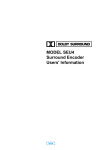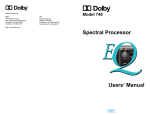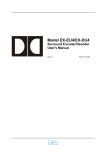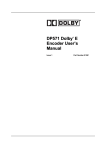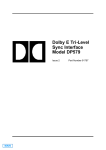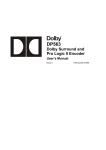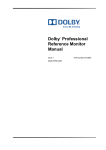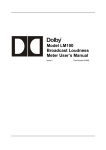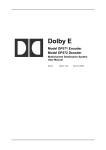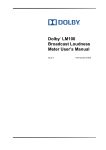Download Dolby Laboratories 430 Operating instructions
Transcript
430 SERIES BACKGROUND NOISE SUPPRESSOR SYSTEM Installation and Operating Instructions MAIN INSTALLATION AND OPERATING INSTRUCTIONS FOR 430 SERIES BACKGROUND NOISE SUPPRESSOR SYSTEM Dolby Laboratories Incorporated U.S.A. 100 Potrero Avenue, San Francisco, CA 94103 Tel: 415-558-0200; Fax: 415-863-1373 U.K. Wootton Bassett, Wiltshire, SN4 8QJ, England Tel: 0793-842100; Fax: 0793-842101; Telex: 44849 WARRANTY INFORMATION: warranty on the product covered by this manual is subject to the limitations and disclaimers set forth in the warranty disclaimer originally shipped with the product and also printed on the back of the invoice. Dolby and the double-D are registered trademarks of Dolby Laboratories Licensing Corporation. ©1994 Dolby Laboratories ISSUE 3 S94/9359/10081 Part No. 91262 MAIN DOLBY 430 BACKGROUND NOISE SUPPRESSOR DOLBY 430 BACKGROUND NOISE SUPRESSOR he Dolby 430 Series is a background noise suppressor system for reducing the broadband noises such as wind or traffic rumble that often mar location recordings. Many mixers in film and television postproduction already rely on Dolby Laboratories’ Cat. No. 43, a background noise suppression unit based on a modified version of Dolby A-type noise reduction. The 430 Series takes this concept further by using a modified version of Dolby SR’s patented combination of fixed and sliding bands to give more stable signal handling and a significantly reduced chance of audible side effects. While superior in performance to the Cat. No. 43, the 430 Series uses fewer controls. Low- and high-frequency faders adjust the amount of noise suppression above and below dominant mid-frequency signals such as dialogue. A pull-to-engage control permits varying the preset operating level for recordings at unusually high or low levels (overall gain of the unit remains fixed). T The 430 Series is a modular system providing from one to six channels of background noise suppression. A single control unit provides power and control signals for up to three single-rackspace frames, each with one or two channels of processing. All operating controls are mounted in a remote control module which may be located up to 15 meters (50 feet) from the control unit. These remote controls have been specifically designed for easy console mounting. Alternatively, a housing is available to allow for standalone operation. 100 Potrero Avenue San Francisco, CA 94103-4813 Telephone 415-558-0200 Fax 415-863-1373 [email protected] Wootton Bassett Wiltshire SN4 8QJ, England Telephone (44) 1793-842100 Fax (44) 1793-842101 [email protected] MAIN www.dolby.com MAIN 430 SPECIFICATIONS DOLBY NOISE REDUCTION Dolby noise reduction is a family of signal processes that reduce the noise inherent in analog recording media, without affecting the sound being recorded. While they differ in performance and details of operation, all Dolby NR systems are complementary processes that first encode the music when it is recorded, then decode it when it is played back. They also treat soft signals separately from loud ones, and vary the NR action with frequency to avoid the side effects typical of other systems. Dolby A-type noise reduction, introduced in 1965, was originally intended for use by professional recording studios to make quieter master tape recordings. In the early 1970s its use was extended to film studios and motion picture release prints to make films sound better. Dolby SR (spectral recording), introduced in 1986, was designed not only to provide more noise reduction than A-type, but also to enable analog master recordings that equal or surpass 16-bit digital recordings with respect to overall dynamic range. Today, analog with Dolby SR is still a preferred format for some musicians, producers, and recording and mastering facilities, and is the standard format for the analog soundtracks of virtually all feature films. Signal Processing Accessories Independent low- and high-frequency stages with maximum noise suppression of approximately 16 and 18 dB, respectively 430SU1: single-channel upgrade package with one channel module, one remote control and rack mounting frame with blanking plate. 430SU2: two-channel upgrade package with two channel modules, two remote controls and rack mounting frame. 430SK1: single-channel upgrade package with one processing module and one remote control only (no frame included). Cat. No. 428: remote housing for up to three Cat. No. 429 remote controls. Signal Connection 3-pin XLR connectors for audio; 34-way ribbon connector links processing module frames to power supply/control unit; one 15-way D-connector connects remote controls for all channels Operating Controls Operating controls for each channel of processing are mounted on Cat. No. 429 Remote Control module Level: rotary control varies signal level in processing circuitry over a ±6 dB range without changing overall gain of unit In/out: push-button with LED indicator switches processing in and out of circuit HF & LF: fader controls set attenuation of unwanted low-level signals Regulatory Notices US: This unit is UL listed. Europe: The 230 Volt unit complies with the requirements of Low Voltage Directive 73/23/EEC. Warranty One-year limited, parts and labor DISCLAIMER OF WARRANTIES: Equipment manufactured by Dolby Laboratories is warranted against defects in materials and workmanship for a period of one year from the date of purchase. There are no other express or implied warranties and no warranty of merchantability or fitness for a particular purpose. Signal Levels Nominal input and output level +4 dBr 1 Input Circuits Electronically balanced, 20 kΩ input impedance, substantially resistive; common mode rejection better than 55 dB, 50 Hz to 10 kHz; maximum input level +27 dBr balanced, +21 dBr unbalanced Output Circuits LIMITATION OF LIABILITY: It is understood and agreed that Dolby Laboratories’ liability whether in contract, in tort, under any warranty, in negligence or otherwise shall not exceed the cost of repair or replacement of the defective components and under no circumstances shall Dolby Laboratories be liable for incidental, special, direct, indirect or consequential damages (including but not limited to damage to software or recorded audio or visual material), or loss of use,revenue or profit even if Dolby Laboratories or its agents have been advised, orally or in writing, of the possibility of such damages. Electronically balanced, approximately 20Ω output impedance; output balance better than 1 dB into a symmetrical 600Ω load; output float 2 better than –40 dB, 50 Hz to 1 kHz; maximum signal level into 600Ω or greater: +26 dBr balanced, +20 dBr unbalanced; either leg of the output can be grounded for unbalanced operation with no change in level Frequency Response ±1 dB 20 Hz to 20 kHz with LF and HF controls set to 0 Crosstalk Channel to channel within a single frame: better than –94 dB 20 Hz to 20 kHz Power Line Input User-selected voltage ranges (50–60 Hz, singlephase); nominally 100 V (85–110 V), 110 V (102–132 V), 220 V (187–242 V), 240 V (204–264 V) Size Processor and power supply/control units: 44 × 483 mm (standard 1.75 × 19 inches rack mounting ); maximum projection behind mounting surface: 330 mm (13 inches) including connectors; remote control panels: 150 mm x 39.5 mm (5.91 × 1.56 inches ); maximum projection behind control surface: 100 mm (3.94 inches) including connectors; may be console-mounted, mounting holes on 142.9 mm (5.63 inches) centers. Weight Model Weights (including remotes): 430-S1, 8 kg (17.5 lb); 430-S2, 9 kg (19.6 lb); 430-S3, 12.9 kg (28.3 lb); 430-S4, 14 kg (30.6 lb); 430-S5, 17.8 kg (39.2 lb); 430-S6, 18.8 kg (41.4 lb) MAIN 1 0 dBr = 0.775 mV 2 Output float is the level across a balanced load relative to an interfering signal injected at one end of the load Specifications subject to change without notice. Dolby and the double-D symbol are trademarks of Dolby Laboratories. © 2000 Dolby Laboratories, Inc. S00/00000 i TABLE OF CONTENTS INTRODUCTION SECTION 1 UNIT CONFIGURATIONS 1.1 1.2 The Model 430 System .................................................................................................. 1-1 Accessories .................................................................................................................... 1-1 SECTION 2 OPERATION 2.1 2.2 2.3 Controls .......................................................................................................................... 2-1 Practical Operation ......................................................................................................... 2-2 Console Signal Path Insertion Guide ............................................................................. 2-3 SECTION 3 INSTALLATION 3.1 3.2 3.3 3.4 3.5 Control unit and Suppressor Frames ............................................................................. Console Mounting of Remotes ....................................................................................... Channel Number Assignment ........................................................................................ Panel Cut-Out Templates for Cat. No. 428 Remotes ..................................................... Regulatory Notices ......................................................................................................... 3-1 3-3 3-3 3-4 3-5 SECTION 4 THEORY OF OPERATION SECTION 5 SCHEMATIC DIAGRAMS APPENDIX A1 Plugging Precautions ..................................................................................................... A-1 MAIN ii INTRODUCTION The Model 430 Series is a playback-only noise reduction system intended primarily to reduce unwanted ambient noise from location recordings. Typically, this noise is generated by broadband sources such as generators, wind, or traffic. The Model 430 Series is a second-generation design, following from the Cat. No. 43 unit—a successful background noise suppressor in widespread use in post-production facilities throughout the world. The Model 430 unit offers several benefits over the earlier design, including improved ease of operation, and a reduced risk of side effects. The earlier design was based on Dolby A-type noise reduction techniques, and incorporated user control of each of its four fixed bands to accomplish playback noise reduction. The Model 430 design is based on Dolby spectral recording techniques, with a multiple combination of low- and high-frequency fixed and sliding bands. Basic user controls have been reduced to two, controlling the amount of playback noise reduction above and below the dominant signal of interest, typically above and below mid-frequency dialog components. The use of Dolby SR fixed and sliding bands in combination results in much more stable signal handling with a significantly reduced chance of audible background signal pumping. Nevertheless, the user is cautioned that, as with all non-complementary playback-only noise reduction devices, excessive use and certain signal combinations can lead to audible side-effects. The Model 430 Series is not intended for suppression of spot-tone signals, such as camera noise or power line hum interference. Noise sources such as this may well be better treated with a dip filter. In typical applications, the Model 430 Series unit is placed in the signal path of a sound mixing console where nominal line levels are present. It is intended to operate at a level around +4 dBr (Ref: 0.775 Vrms). MAIN 1-1 SECTION 1 UNIT CONFIGURATIONS 1.1 The Model 430 System The Model 430 is a modular system which has a control unit containing the power supply and microprocessor. The control unit links to one or more enclosures each of which contains one or two noise suppression modules and also links to one or more remote control modules. The 40mm wide format of the remote control modules makes them easily mountable in spare sections of many mixing consoles. Alternatively, they may be mounted in an optional housing which can mount up to three remote control modules. Linking of the units is accomplished by a short ribbon cable bus between the control unit and the suppressor module enclosures and a 15-meter shielded cable between the control unit and remote control modules. Where the remotes are console mounted, there are 15-way ribbon cable assemblies which allow flexible use of the spare space in the console. The figure below shows a complete 6-channel system along with the various component part numbers. 430PS POWER SUPPLY AND CONTROL UNIT Dolby 430 Series Control Unit 430SU2 430SU2 430SU2 PART NO. 83121 430 SERIES CHASSIS GROUND LINK Channels Remote Error Channel Error 1 3 2 4 5 6 2 CHANNEL SUPPRESSOR UNIT Dolby Cat. No. 413 430 Series Noise Suppressor Module Normal Bypass Dolby Cat. No. 413 430 Series Noise Suppressor Module Normal Bypass PART NO. 83128 430 SERIES 15 METER REMOTE CABLE PART NO. 83093 430 SERIES 6 CHANNEL FLAT CABLE 2 CHANNEL SUPPRESSOR UNIT Dolby Cat. No. 413 430 Series Noise Suppressor Module Normal Bypass Dolby Cat. No. 413 430 Series Noise Suppressor Module Normal Bypass 2 CHANNEL SUPPRESSOR UNIT Dolby Cat. No. 413 430 Series Noise Suppressor Module Normal Bypass Dolby Cat. No. 413 430 Series Noise Suppressor Module Normal Bypass PART NO. 83131 430 SERIES REMOTE EXTENSION CABLE (ALSO USED FOR 4 REMOTES) PART NO.83127 430 SERIES 3 REMOTES CABLE Clip Clip Pull to Pull to Adjust Adjust Level Level LF Level Clip CAT. NO. 429 REMOTE CONTROLS Clip Clip Pull to Pull to Pull to Adjust Adjust Adjust Level Level Level 0 0 0 0 0 0 1 1 1 1 1 1 2 2 2 2 2 2 3 3 3 3 3 4 4 4 4 4 4 5 5 5 5 5 5 LF HF Dolby 430 Series Remote Clip Pull to Adjust LF HF Dolby in 430 Series Remote LF HF Dolby in 430 Series Remote LF HF Dolby in 430 Series Remote A1F4356B REV2 MAIN 3 LF HF Dolby in 430 Series Remote HF Dolby in 430 Series Remote in 1-2 1.2 Accessories The figure below shows the various 430 Series accessories available. These items can be ordered to expand an existing system. 430SK1 1 CHANNEL SUPPRESSOR KIT Clip CAT. NO. 429 REMOTE CONTROL Pull to Adjust Level CAT. NO. 413 NOISE SUPPRESSOR BOARD 0 1 Dolby Cat. No. 413 430 Series Noise Suppressor Module Normal Bypass 2 3 4 5 LF HF Dolby 430 Series Remote in Clip Clip Pull to Pull to Adjust Adjust Level Level 430SU2 2 CHANNEL SUPPRESSOR UNIT CAT. NO. 429 REMOTE CONTROLS Dolby Cat. No. 413 430 Series Noise Suppressor Module Normal Dolby Cat. No. 413 430 Series Noise Suppressor Module Normal 0 0 1 1 2 2 3 3 Bypass Bypass 4 4 5 5 LF LF HF Dolby 430 Series Remote 430SU1 HF Dolby in 430 Series Remote in Clip 1 CHANNEL SUPPRESSOR UNIT Pull to Adjust Level Dolby Cat. No. 413 430 Series Noise Suppressor Module Normal Bypass 0 1 2 3 4 5 LF PART NO. 63413 BLANK PANEL HF Dolby 430 Series Remote in CAT. NO. 429 REMOTE CONTROL CAT. No. 428 3 CHANNEL REMOTE HOUSING PART NO. 83031 EXTENSION CABLE FOR CAT. NO. 428 (FOR ADDING A SECOND REMOTE HOUSING) REMOTE HOUSING Dolby Dolby 430 Series Remote Pod 430 Series Remote Pod Clip Pull to Adjust Level PART NO. 63415 BLANK PANELS LF MAIN Level 0 0 0 1 1 1 2 2 2 3 3 3 4 4 4 5 5 5 LF HF Dolby 430 Series Remote Clip Pull to Adjust Level A1F4356A Clip Pull to Adjust LF HF Dolby in 430 Series Remote HF Dolby in 430 Series Remote in 2-1 SECTION 2 OPERATION 2.1 CONTROLS Operation of the Model 430 is very simple. The basic controls and indicators mounted on the Cat. No. 429 remote for each channel are described below. 3 Clip Pull to Adjust 4 2 Level 0 1 2 3 4 5 LF HF Dolby 430 Series Remote in 1 A1F4356F 1 In/Out Switch and Indicator This push-button switches all processing in and out so that the effect can be checked against the original track. An LED indicator on the remote unit confirms switch action. The NORMAL and BYPASS LEDs on each Cat. No. 413 suppressor module also change state when this button is pushed which is useful for checking which remote is controlling which channel. 2 Level Indicating Meter This LED meter array indicates signal present, normal level, high-level and clip. The meter array allows the user to trim the normal dialog level to bring it into the optimum range using the level setting control described below. The lower LED acts as a “signal present” indicator and comes on for an output level of about –30 dB and above. The metering circuit is located after processing but before output level normalizing so the “signal present” LED particularly will respond to movements of the sliders where there is a fairly dominant noise component. The rotary level control will directly affect the meter indication. The upper “clip” LED starts to flash when peaks of about 6 dB below actual clipping are occurring internally and stays on if full clipping is encountered. 3 Level Control This rotary control, when pulled out, is a trim on the internal level applied to the two processing bands. It does not, of itself, change the gain of the unit. Loss at the input is made up by gain at the output and vice versa. As it is moved the meter shows that the internal level is changing. Ideally, the level control should be set so that normal voice is lighting the three central LEDs more or less equally. MAIN 2-2 4 High-frequency and Low-frequency Suppression Controls The left-hand slider controls the amount of low level LF attenuation the unit applies; the right-hand slider controls the low level HF attenuation. When the controls are at the top there is no processing, and at the bottom there is maximum processing. The effect is gradual with about half scale giving enough processing for most applications; only on severely noisy tracks will more than half scale be needed. Maximum attenuation is approximately 16 dB at low-frequencies, and 18 dB at high-frequencies. 2.2 PRACTICAL OPERATION If the amount of noise that needs to be suppressed is small, i.e., the noise itself is at a low level, then the amount of processing needed will be small, and the change from expansion to linear (no processing) will be so gentle and gradual that the default setting of the rotary level control (pushed in) will give good results on virtually all types of dialog and interference. In fact, for small amounts of processing, the effect of the control is almost inaudible. On the other hand, if the unwanted background noise is relatively loud and there is only a small difference between speech level and the background noise, then maximum or near maximum processing may be required. The rotary level control should be pulled out and set so that normal voice is lighting the three central LEDs more or less equally (there is little or no processing at ±10 dB of nominal level). This gives a visual indication that the dialog lies in the linear (no processing) band and the noise can then be suppressed by drawing down the sliders. If the level of the track is too high or the rotary level control too far clockwise, then noise can start to enter the linear band and processing will be partially lost. If the track level is too low or the level control too far counterclockwise, then the voice will take on an expanded character with poorly controlled dynamics. Noise will be modulated by the voice more and the voice will be dulled by the HF control and dried by the LF control. In situations where there is too much reverberation, a combination of HF and LF processing increases intelligibility and reduces the perceived reverberation time. Similar treatment is also useful in situations where dialog has been overcompressed by ALC circuits in portable camcorders or similar recording equipment. If the interference is broadband, clearly both the LF and HF bands can be used in varying amounts. The expander sections are in series so their effects tend to sum. For this reason, the amount of processing used can often be reduced when both bands are brought into play since they broadly overlap in the range of 200 Hz to 2kHz. 2.3 CONSOLE SIGNAL PATH INSERTION GUIDE The choice of Model 430 insertion point in the console chain is very important for best results. Where the dialog already lacks presence, HF processing will tend to accentuate the problem and sibilants will become more muffled except when they occasionally come through clearly giving an impression of poorer vocal control than the original track. Under these circumstances, an equalizer should precede the unit to bring the sibilants up into the linear region of operation in the Model 430. As with other playback-only devices, a large amount of high-frequency low level attenuation may subjectively lower the HF speech content. This effect can be compensated by judicious use of console equalization after the Model 430 unit. When there is a strong interfering tone such as AC power buzz or generator hum, this is best reduced by high pass filtering before Model 430 processing so that the level difference between noise and dialog can be maximized, reducing the amount of processing required. If intrusive noise includes spot tonal signals along with ‘noise blanket’ components, the spot tones should be attenuated prior to suppression of the wide-band noise components, e.g., dip filters should precede the Model 430 in the signal chain. On the other hand, owing to the filtering nature of the treatment, it may be more pleasing to lightly equalize the output of the Model 430 processor at the opposite end of the spectrum to that at which treatment has been selected so that the effective passband is more balanced about the 200 to 2 kHz decade. MAIN 2-3 It is usually better to locate the console channel fader after the Model 430 unit. Gain riding the Model 430 input can allow dialog to move into the expansion band resulting in unexpectedly increased dynamic range. Also, when the Model 430 is being used to reduce reverberation the process can change the perceived loudness of the track (even though levels around nominal are virtually untouched). The fader can then be used to restore the perceived loudness without affecting the noise suppression thresholds. If a track has been recorded at much lower than nominal level, (i.e., not riding around the level of the three center LEDs on the meter with the uncal pot out and fully clockwise), it is important to bring up the send signal to the Model 430 with the console’s line gain control rather than raising the fader to bring up the processed level. The use of compression in the chain containing the Model 430 is to be avoided wherever possible. Compression will counteract the effect of the suppressor by raising background noise. If the level of suppression is high, peaks can sometimes sound objectionable. The use of a peak limiter after the suppressor can be useful in this case. Its threshold should be set about 6 to 10 dB above nominal level. This will trim back the peaks of dialog and give a more balanced track. Attack and release times should be set to roughly syllabic rate (around 10 ms attack and 150-300 ms release) to minimize the audible effect of the limiter. MAIN 3-1 SECTION 3 INSTALLATION 3.1 Control unit and Suppressor Frames The installation of Model 430 series consists of plugging together the component parts and rack mounting (prefereably) the control unit and each two-channel frame. Taking a typical system with three channels, the procedure is as follows: The system should be unpacked and inspected for damage. Any damage should be reported to the carrier and distributor immediately. The control unit/power supply should be checked for AC voltage setting and fuse value. Open the fuse compartment door in the power input connector with a small flat-blade screwdriver (see figure), and check that the fuse has the correct rating. If necessary, rotate the selector drum until it displays the correct voltage for the installation. (The drum may also be removed and replaced in the desired position; it will only fit one way round.) FUSE FUSE OPEN THE DOOR ROUND PEG OCTAGONAL PEG A2F4038 SPARE FUSE CARRIER (LOWER) VOLTAGE SELECTOR WHEEL ACTIVE FUSE CARRIER (UPPER) The correct fuse value and type is: For 100/120 Vac use 1.25A / 250V 1/4" x 1-1/4" slow-blow fuse For 220/240 Vac use T630 mA / 250V 5 x 20mm time-lag fuse The cover should then be snapped closed but the main power left unconnected until the rest of the installation is complete. Next, the 34-way ribbon cable assembly should be located and the polarizing bumps in the center of one flat side of the connectors located. The slot in the rear of the control unit has two cable retainers which locate around the back of the ribbon connector. These retainers should be separated slightly to allow the connector to enter. Taking the connector at one end of the assembly, insert it into the slot with the polarising bump uppermost. Note the connector cannot be made to mate with the polarizing bump downwards unless extreme force is applied, enough to break the plug in the slot. If any substantial resistance is felt, then the connector should be withdrawn and its orientation checked. As the connector mates, the two retainers should close over the back as it seats home. If their tips are not hooked over the back of the connector, check to see that it is properly seated. MAIN 3-2 Similarly there is a slot in the back of each two-channel frame and the other connectors should be mated, (bump upwards) with these observing the warning about excessive force. The channel frames can be stacked with the control unit at the top or bottom. Next, the 15 meter shielded cable should be located and plugged into the 15-way D connector on the back of the control unit. The other end of this cable connects directly to the rear of an optional Cat. No. 428 three-channel remote housing or to the flat cable which links three freestanding remote control units for console mounting. Next, the audio in/out connections should be made. The connectors for this are standard XLR type 3-pin audio connectors. Connect audio cables to the inputs and outputs using two-conductor shielded cable. Connect shields at one end only to avoid ground loop problems. The XLR connectors are wired with pin 1 as ground and pins 2 and 3 as an electronically balanced pair. Phase continuity is preserved with the same pin numbers used for input and output. In an installation where the source and/or load are unbalanced, avoid ground loops by using two-conductor shielded cable exactly as for balanced circuits and ensure that the unbalancing (connecting one of the two balanced signals to ground) occurs only at the end remote from the Model 430. Both audio signals must be connected; neither may be left open. In the interests of maintaining international standardization, we suggest that you follow the IEC convention: XLR pin 2 signal is “high/hot” and pin 3 signal is “low/cold.” GROUNDING–To ensure conductivity between all the cases of the modules making up the system, the green/yellow jumper links should be attached to the lugs provided in the middle of the back of each module in a daisy chain fashion. This should be done even in rack mounted installations since paint and anodizing can prevent a low impedance path from existing between the modules. It is normal practice to connect program (audio) ground to power line ground for many reasons, including safety. On occasion (particularly with long signal lines or incorrect wiring of the cable shields) induced hum can sometimes be reduced by separating the two grounds. A link behind the front panel of the control unit provides this feature. There is always a 1 k ohm resistor across the link so that the audio ground is never totally isolated from the chassis ground. Verify that all connectors are securely mated and read the safety information on page 3-5. When you are confident that you have observed its provisions, connect the power cable between the control unit and a power outlet. Power up the unit. The LEDs on the front of the control unit should indicate that channels 1 to 3 are present and that there are no errors. Errors are channels which have no remote addressed to them or remotes with no channels to control. As shipped, the frame with a pair of modules installed will have the addresses set to channels 1 & 2 and the frame with a single module will have its module address set to channel 3. (If errors are found at this stage, see Channel Number Assignment in Section 3.3.) The unit powers up with processing off. To verify which remote unit controls which channel, the button on the bottom of the remote unit should be pressed to see which channel responds by changing the state of its front panel LEDs. An audio signal should be applied to each channel in turn and the effect of moving the various controls verified. MAIN 3-3 3.2 Console Mounting of Remotes. If optional Cat. No. 428 remote housings (holding up to three remote control units each) are not used, the remote controls can be placed in spare sections of the console. The size of each remote unit is 150 mm x 39 mm with a maximum projection behind the control surface of 100 mm. The shielded cable connecting them to the main control unit can run in any convenient trunking to the console although trunking which carries high level signals is preferred. The short link between the remote contol units is unshielded ribbon cable and carries a low level waveform which can radiate interference into mixing busses and microphone inputs if held very close to them. These facts should be kept in mind when selecting suitable sites for the remotes. If blanking panels are available, these can be cut with a slot to mount the remote control modules. 3.3mm DIA (1/8" DIA) DRILL TWO HOLES FOR M3 SCREWS m 0m 10 RS TO ) " 4 ( EC N N CO G DIN LU INC Pu ll to Ad jus t 143 mm Cli p m 2m 13 ") 2 . 5 ( (5-5/8") Le ve 132 mm l 15 0m m (5. 9") (5-3/16") 2 3 4 5 LF 16.5mm 5.5mm (21/32") (7/32") HF Do 43 0 Se rie Re s mo te lby in 33 mm (1-5/16") TAPPED FOR M3 SCREWS 39 mm (1. 5") A1F4356D 3.3 Channel Number Assignment As in any bussed system each element of the system has an address. To determine its address, the Cat. No. 413 suppressor module has to be withdrawn from the chassis. The two front panel knurled screws which hold the module in the frame should be loosened and the module withdrawn using the handle. At the back right-hand side of the printed circuit board is a rotary switch with either a pointer pointing towards a number printed on the switch or a slot in the top with a number showing. This number is the address of the module. Normally the upper module in the rack is given the lowest address so the switch in this module should be set to “1”; the next module’s switch should be set to “2” and so on. Similarly the remote control modules have addresses. The rotary switch which sets it can be seen through a hole in the back cover of each remote module. The positions of the switches should match the addresses of the Cat. No. 413’s they control so channel 1’s remote should have the address switch pointing to channel 1, etc. Selection requires a small screwdriver to rotate the switch to the required channel. Note switch positions 0, 7, 8 and 9 are not used. If the optional Cat. No. 428 remote control housing is used, the base must be removed by unscrewing the six screws on either side of the housing. When the base is slid off, the backs of the remote modules are exposed. MAIN 3-4 3.4 Panel Cut-Out Templates for Cat. No. 428 Remotes The templates below can be removed from this manual and used to cut/drill blank console panels. A1F4356C MAIN 3-5 3.5 Regulatory Notices WARNING: Check that the unit has been set to the correct supply voltage and that the correct fuse is installed. To reduce the risk of fire, replace the fuse only with the same type and rating. For 100/120 Vac, use 1.25A/250 V 1/4" x 1-1/4" slow-blow fuse. For 220/240 Vac, use T630 mA/250 V 5 x 20mm time-lag fuse. The power supply input connector has positions for two fuses and will accept carriers for either 20 mm or 1.25" fuses; only the upper fuse position is electrically connected. Select the appropriate fuse and carrier, and insert the assembly into the upper position with the arrow on the carrier in the same direction (upwards) as the arrows inside the compartment door (Note: a spare fuse of the same rating and type can be put in the lower position). When closing compartment door, make sure that it clicks firmly into place. To ensure proper operation and guard against potential shock hazard, the unit must be connected only to a properly wired, grounded (earthed) power outlet. If you are uncertain about the wiring of your outlet do not use it. Consult a qualified electrician. The power cable is furnished either with a standard U.S.A. threeprong plug or with unterminated leads for use in other countries. The wires are colored as follows. live or hot neutral earth International brown blue green/yellow U.S. black white green or green/yellow Before the power cable is connected to the unit, ensure that a qualified electrician has wired it as above. Troubleshooting must be performed by trained technicians. Do not attempt to service the unit unless you are qualified to do so. U.S. Style Plugs The ground terminal of the plug is connected directly to the chassis of the unit. For continued protection against electric shock, a three-pin power receptacle MUST be used, and the ground wire MUST always be connected. DO NOT use a ground-lifting adaptor and NEVER cut the ground pin on a three-prong plug. Connections for United Kingdom WARNING: THIS APPARATUS MUST BE EARTHED. As the colours of the cores in the mains lead may not correspond with the coloured markings identifying the terminals in your plug, proceed as follows: - the core which is coloured green and yellow must be connected to the terminal in the plug which is marked with the letter E or by the earth symbol , or coloured green or green and yellow. - the core which is coloured blue must be connected to the terminal which is marked with the letter N or coloured black. - the core which is coloured brown must be connected to the terminal which is marked with the letter L or coloured red. MAIN 3-6 IEC NOTICES IMPORTANT SAFETY NOTICE This unit complies with the safety standard IEC65. To ensure safe operation and to guard against potential shock hazard or risk of fire, the following must be observed: • Ensure the voltage selector is set to the correct mains voltage for your supply. • Ensure fuses fitted are the correct rating and type as marked on the unit. • The unit must be earthed by connecting to a correctly wired and earthed power outlet. • The power cord supplied with this unit must be wired as follows: Live—Brown Neutral—Blue Earth—Green/Yellow GB IMPORTANT – NOTE DE SECURITE Ce materiel est conforme à la norme IEC65. Pour vous assurer d'un fonctionnement sans danger et de prévenir tout choc électrique ou tout risque d'incendie, veillez à observer les recommandations suivantes. • Le selecteur de tension doit être placé sur la valeur correspondante à votre alimentation réseau. • Les fusibles doivent correspondre à la valeur indiquée sur le materiel. • Le materiel doit être correctement relié à la terre. • Le cordon secteur livré avec le materiel doit être cablé de la manière suivante: Phase—Brun Neutre—Bleu Terre—Vert/Jaune F WICHTIGER SICHERHEITSHINWEIS Dieses Gerät entspricht der Sicherheitsnorm IEC65. Für das sichere Funktionieren des Gerätes und zur Unfallverhütung (elektrischer Schlag, Feuer) sind die folgenden Regeln unbedingt einzuhalten: • Der Spannungswähler muß auf Ihre Netzspannung eingestellt sein. • Die Sicherungen müssen in Type und Stromwert mit den Angaben auf dem Gerät übereinstimmen. • Die Erdung des Gerätes muß über eine geerdete Steckdose gewährleistet sein. • Das mitgelieferte Netzkabel muß wie folgt verdrahtet werden: Phase—braun Nulleiter—blau Erde—grün/gelb D NORME DI SICUREZZA – IMPORTANTE Questa apparecchiatura è stata costruita in accordo alle norme di sicurezza IEC 65. Per una perfetta sicurezza ed al fine di evitare eventuali rischi di scossa êlettrica o d'incendio vanno osservate le seguenti misure di sicurezza: • Assicurarsi che il selettore di cambio tensione sia posizionato sul valore corretto. • Assicurarsi che la portata ed il tipo di fusibili siano quelli prescritti dalla casa costruttrice. • L'apparecchiatura deve avere un collegamento di messa a terra ben eseguito; anche la connessione rete deve avere un collegamento a terra. • Il cavo di alimentazione a corredo dell'apparecchiatura deve essere collegato come segue: Filo tensione—Marrone Neutro—Blu Massa—Verde/Giallo I AVISO IMPORTANTE DE SEGURIDAD Esta unidad cumple con la norma de seguridad IEC65. Para asegurarse un funcionamiento seguro y prevenir cualquier posible peligro de descarga o riesgo de incendio, se han de observar las siguientes precauciones: • Asegúrese que el selector de tensión esté ajustado a la tensión correcta para su alimentación. • Asegúrese que los fusibles colocados son del tipo y valor correctos, tal como se marca en la unidad. • La unidad debe ser puesta a tierra, conectándola a un conector de red correctamente cableado y puesto a tierra. • El cable de red suministrado con esta unidad, debe ser cableado como sigue: Vivo—Marrón Neutro—Azul Tierra—Verde/Amarillo E VIKTIGA SÄKERHETSÅTGÄRDER! Denna enhet uppfyller säkerhetsstandard IEC65. För att garantera säkerheten och gardera mot eventuell elchock eller brandrisk, måste följande observeras: • Kontrollera att spänningsväljaren är inställd på korrekt nätspänning. • Konrollera att säkringarna är av rätt typ och för rätt strömstyrka så som anvisningarna på enheten föreskriver. • Enheten måste vara jordad genom anslutning till ett korrekt kopplat och jordat el-uttag. • El-sladden som medföljer denna enhet måste kopplas enligt foljande: Fas—Brun Neutral—Blå Jord—Grön/Gul S BELANGRIJK VEILIGHEIDS-VOORSCHRIFT: Deze unit voldoet aan de IEC65 veiligheids-standaards. Voor een veilig gebruik en om het gevaar van electrische schokken en het risico van brand te vermijden, dienen de volgende regels in acht te worden genomen: • Controleer of de spanningscaroussel op het juiste Voltage staat. • Gebruik alleen zekeringen van de aangegeven typen en waarden. • Aansluiting van de unit alleen aan een geaarde wandcontactdoos. • De netkabel die met de unit wordt geleverd, moet als volgt worden aangesloten: Fase—Bruin Nul—Blauw Aarde—Groen/Geel MAIN NL 4-1 SECTION 4 THEORY OF OPERATION Based on the Dolby SR spectral recording system, the Model 430 series design incorporates two separate noise reducing bands; one for low and the other for high frequencies. Unlike SR, however, the degree to which the signal is treated can be controlled by two slider controls and the level at which the expanders work is adjustable by a rotary control which has a nominal “cal” position. In typical applications, the Model 430 is placed in the signal path of a sound mixing console where nominal line levels are present. It is intended to work at a level around +4 dBr (Ref: 0.775 Vrms = 0 VU = 0 dBr). With maximum processing selected, the two noise reduction paths form level dependent shelves in their responses whose depth increases with decreasing input signal level. For the LF section where control of rumble, hum, generator noise, fan or wind noise is required, the response at low levels is a shelf which is flat for high frequencies and, starting at around 2 kHz, falls to a maximum attenuation of about 18 dB at 30 Hz. As the level of low frequencies increases the response flattens out so that around 10 dB either side of the nominal level there is little or no processing. See the figure below. +10 VU (+4 dB)0 VU –10 –20 –30 –40 –50 –60 –70 VU 20 Hz 100 Hz 1 kHz 10 kHz 20 kHz Similarly for the HF band, where control of amplifier hiss and noise, tape noise, rain noise, script rustle or lighting “sing” is required, the response at low levels is a shelf which is flat at low frequencies and from about 200 Hz, starts to fall so that, at 8 kHz the response is around 16 dB down from flat. Again, as the level rises the curve flattens out so that around 10 dB below and above the nominal level there is little or no processing. See the figure below. (+4 dB) 0 VU –10 –20 –30 –40 –50 –60 –70 –80 VU 20 Hz 100 Hz 1 kHz MAIN 10 kHz 20 kHz 4-2 In situations where the interference is broadband, both the LF and HF bands can be used in varying amounts. The two expander sections are in series therefore their effects tend to sum. For this reason, it will be found that the amount of processing used can often be reduced when both bands are brought into play since they broadly overlap in the band 200 Hz to 2 kHz. } (+4 dB) 0 VU Dialog Range –10 –20 –30 –40 –50 –60 –70 –80 VU 20 Hz 100 Hz 1 kHz 10 kHz 20 kHz For each band, there is an untreated path which is mixed with the treated path in variable amounts determined by the position of two controls on the remote unit in such a way that, for nominal level signals, the change from untreated path to treated path causes no audible change in level. This is useful because it allows the sound engineer to treat the noise rather than having to juggle with the predominant signal. As the amount of untreated signal increases, it progressively dilutes the effect of the processing without changing thresholds, forming a natural progression from processed to linear effect. MAIN 5-1 SECTION 5 SCHEMATIC DIAGRAMS- Contact Dolby Laboratories Figure 5-1 Figure 5-2 Figure 5-3 Figure 5-4 Figure 5-5 Figure 5-6 Power Supply ......................................................................................................................... 5-2 Control Circuit ........................................................................................................................ 5-3 Cat. No. 413 Voltage Regulation/Smoothing ......................................................................... 5-4 Cat. No. 413 Signal I/O .......................................................................................................... 5-5 Cat. No. 413 Interface Logic/Metering ................................................................................... 5-6 Cat. No. 429 Remote Control ................................................................................................. 5-7 MAIN A-1 APPENDIX A1 Plugging Precautions Any Cat. No. 413 suppressor module can be removed and replaced with the power applied. However it will only take on the settings determined by its remote contol unit after every control on the remote has been exercised. Similarly, the remote controls can be plugged and unplugged with the power on although it has been found that the normal bypass indicator can occasionally get out of sync with the front panel LEDs if the reconnection is not made smoothly. The 34-way ribbon cable between the 430 control unit and the supressor module frames should NEVER be plugged or unplugged with the power on (from either the control unit end or any of the module frame ends). At best the unit will stop responding to controls and need to be powered down and back up to reset the processor and at worst SERIOUS DAMAGE can be caused. MAIN





















